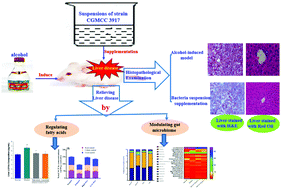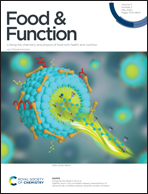Komagataeibacter hansenii CGMCC 3917 alleviates alcohol-induced liver injury by regulating fatty acid metabolism and intestinal microbiota diversity in mice
Abstract
The potential effects of Komagataeibacter hansenii CGMCC 3917 cells on alcohol-induced liver injury and their probable mechanisms were investigated. Male Kunming mice were orally administered with alcohol (10 mL per kg BW) alone or in combination with administration of K. hansenii CGMCC 3917 cells at 2 × 108 and 2 × 106 CFUs for 10 weeks. Administration of strain CGMCC 3917 cells, especially high dose administration, decreased the liver weights, fat gain, and fatty-acid metabolism-related enzyme SCD-1, ACC and FAS expressions and endotoxin release, which were elevated by alcohol treatment. Furthermore, the total contents of long chain fatty acids of the liver and serum in alcohol-treated mice supplemented with a high dose of strain CGMCC 3917 cells were decreased to 5.44 ± 0.19 μg mL−1 and 3.66 ± 0.15 μg mL−1 from 6.65 ± 0.31 μg mL−1 and 4.52 ± 0.21 μg mL−1, respectively. Conversely, the SCFAs decreased by ethanol treatment, particularly the acetic acid, propionic acid and butyric acid, were obviously enhanced in the faeces, colon and cecum of the mice supplemented with strain CGMCC 3917 cells. Moreover, strain CGMCC 3917 cells could regulate gut microbiome by significantly decreasing the abundance of Actinobacteria, Proteobacteria and Firmicutes, and dramatically increasing the abundance of Bacteroidetes in alcohol-treated mice. These findings suggest that K. hansenii CGMCC 3917 cells alleviate alcohol-induced liver damage via regulating fatty acid metabolism and intestinal microbiota diversity in mice.



 Please wait while we load your content...
Please wait while we load your content...